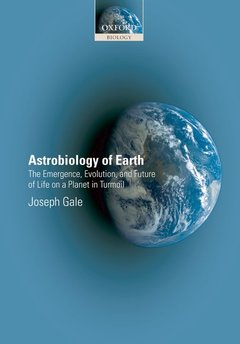Astrobiology of Earth The emergence, evolution and future of life on a planet in turmoil
Langue : Anglais
Auteur : Gale Joseph

The study of life in our universe has been given the name 'astrobiology'. It is a relatively new subject, but not a new discipline since it brings together several mature fields of science including astronomy, geology, biology, and climatology. An understanding of the singular conditions that allowed the only example of life that we know exists to emerge and survive on our turbulent planet is essential if we are to seek answers to two fundamental questions facing humanity: will life (and especially human life) continue on Earth, and does life exist elsewhere in the universe? Astrobiology of Earth adopts a unique approach that differs from most texts in the field which focus on the possibility of extraterrestrial life. In contrast, the central theme of this book is the fortuitous combination of numerous cosmic factors that together produced the special environment which enabled the emergence, persistence and evolution of life on our own planet, culminating in humanity. This environment has been subject to constant and chaotic change during life's 3.6 billion year history. The geologically very recent appearance of humans and their effect on the biosphere is discussed in relation to its deterioration as well as climate change. The search for extraterrestrial life is considered with a view to the suggestion that humans may escape a depleted Earth by colonizing the universe. This book contributes to our understanding of astrobiology from the perspective of life on Earth and especially human welfare and survival. Astronomical and geological phenomena are related in turn to their biological relevance and impact. This introductory text assumes little or no prior knowledge of more specialized scientific fields and is designed for undergraduate and graduate level students taking related courses in departments of biology, earth science/geology, and environmental science. It will also serve as a useful biology primer for astronomy majors.
Introduction. Abbreviations. 1. What is Life? Why Water?. 2. The Universe from the Perspective of Biology. 3. The Solar System and Life on Earth (a). 4. The Solar System and Life on Earth (b). 5. Early and Present Earth and its Circumnavigation of the Sun. 6. Origin of Life and Photosynthesis. 7. Setting the Stage for the Evolution of life on a Tumultuous Planet. 8. Mechanisms of Evolution: from First Cells to Complex Life and Extremophiles. 9. The Evolution of Humans and their Interactions with the Biosphere. 10. In Search of Extraterrestrial Life. Epilogue. Appendix (A Workshop Guide). References. Index.
Joseph Gale was born in London, UK but immigrated to Israel in 1948. He studied at The Hebrew University, Jerusalem, and then completed his advanced studies at the University of California and the University of Michigan, USA. He was a visiting professor at McGill University in Canada and the Ben Gurion University (BGU) in Israel. At BGU he headed a research department and served as Institute Director and head of the International Center. His environmental expertise and experience in military and commercial aviation led to participation in a NASA project for Controlled Environment Life Support Systems for space flight. He has published more than one hundred refereed papers and co-edited/authored two books. Presently he is Professor Emeritus at Hebrew University where he teaches a course on the Astrobiology of Planet Earth.
The author has chosen to focus on Earth life, our place in the universe and, uniquely for an astrobiology textbook, our future existence in light of our continuing environmental impact. The writing style is informal and friendly it has a thorough index and reference section, as well as a helpful guide to Internet resources. A nice addition is the "workshop guide" for teaching the course, which will be especially useful for new professors.
Date de parution : 04-2009
Ouvrage de 262 p.
16.7x23.9 cm
© 2024 LAVOISIER S.A.S.



